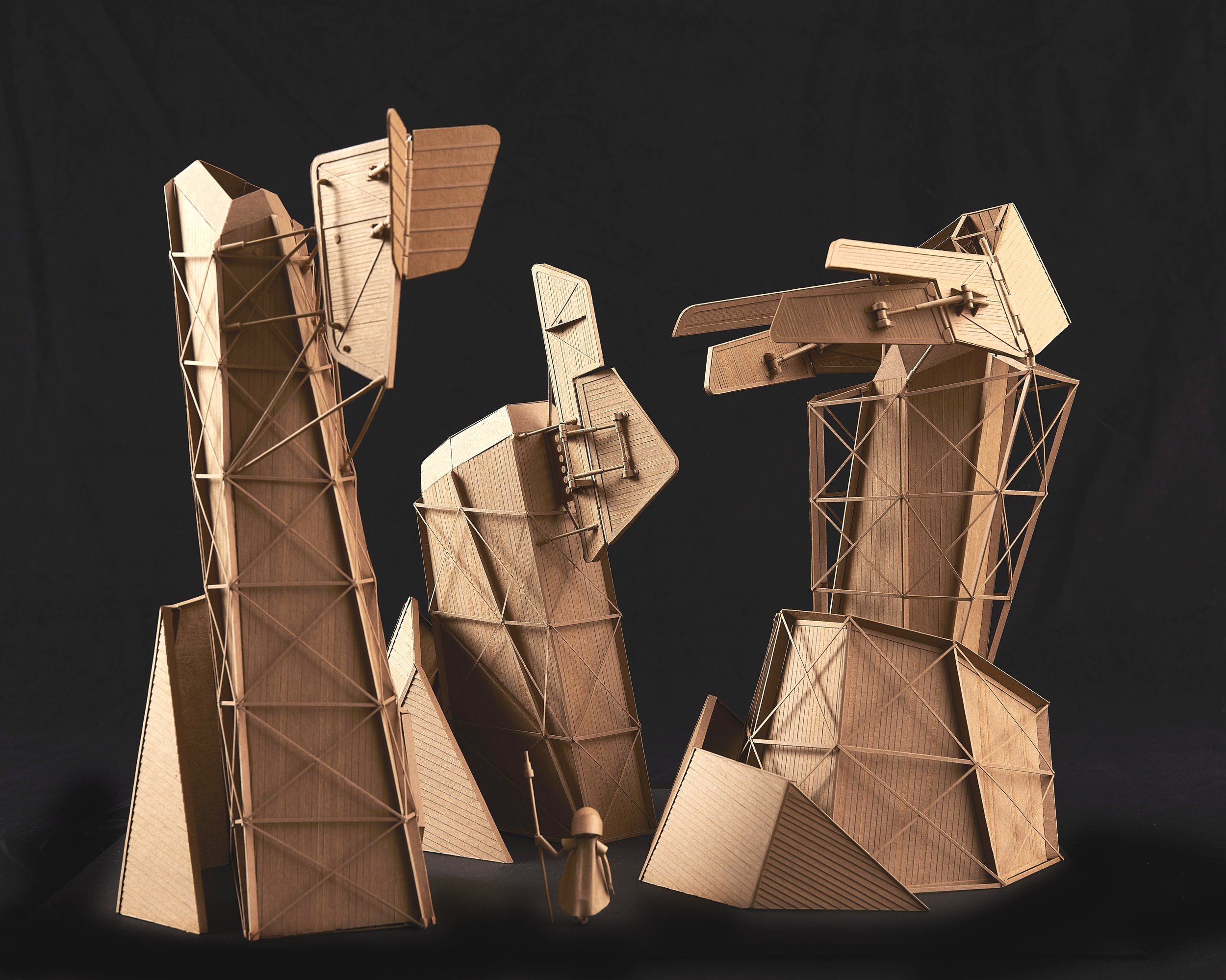
Why cardboard?
Cardboard is a great medium to work with; it’s cheap, strong, flexible, easy to cut, bend, glue, fold, crease, stamp and drill. It required few tools to fashion, doesn’t require a large workspace, makes no noise while fabricating, produces no dust and the finished pieces weigh almost nothing. The cardboard I use now, a recycled, commercial, packaging grade card, has a rich natural colour with a subtle texture.
By using a monochromatic material, like working in marble or bronze, the uniform colour helps to focus the viewer on the form and detail. I am asked occasionally why I don’t add colour to the finished constructions. In an age of 3D printers, laser cutters and CNC machines where any imagined detail or form can be programmed and machined, the decision to leave the sculptures in their natural state celebrates the material and basically says ‘these are handmade, the imperfections, the design resolutions are there for all to see’.
What sort of cardboard and glue do you use?
I get asked this a lot. I use a packaging grade cardboard which, in Australia, goes by the name of Buffalo board. It comes in several weights including 90, 225, 283 and 386 gsm (grams per square metre). My background is as a graphic designer so I discovered this in a paper sample catalogue many years ago and I purchase it cut to A3 sheets for me, or in much larger full sheets, from Pedigree Paper, the retail arm of a paper merchant in Australia - I believe the non-proprietary equivalent is something called kraft board which can be purchased on several eBay sites. I use a normal PVA woodworking glue, in Australia called Selleys Aquadhere Quickset. Goes on white and dries clear. Ideal for use with the slightly fibrous cardboard I use.
Do you use 3D software or cutting machines to create the sculptures?
No, all of my work is made up as I go, which makes it impossible to draw every piece out on a computer ahead of time. I simply start out with a general idea of what I am after and start cutting. Working in 3 dimensions means I can assess each piece as I go and see how the next bit will connect with it. I can also see opportunities that present themselves along the way that I wouldn’t have thought of if I had planned everything ahead of time. Cardboard allows a freedom to create and remake elements relatively quickly. Using a laser cutter would also require creating digital files for the cutter and would leave the cardboard edges burnt.
Is your work for sale?
Absolutely! I’m not exactly Elon Musk, and cardboard doesn’t grow on trees you know!! And I’m running out of space in the spare bedroom. All the pieces on this site are marked as For sale, For gallery sale, Sold or are unfinished and a work in progress, with the price to be determined upon completion. The prices for the For Sale ones are on each sculpture’s respective page and are in Australian Dollars. Some of the pieces are currently in a gallery’s inventory following recent exhibitions and the prices are as per the gallery’s website. These pieces are spoken for by the gallery until the gallery’s consignment period (usually 6 months from the opening) expires or the piece is sold.
Do you take commissions?
Indeed I do! Email me with a request at mail@commdc.com.au. Pricing will obviously vary depending on a sculpture’s size and complexity. The prices of unsold pieces on this website will give you an idea of pricing of typical works, again based on size and complexity. If you are working to a budget, let me know and I can propose a piece that suits. Even a small sculpture usually takes a minimum of a week of work so costs start at around AUD$1000. This results in a piece of art that is unique, never to be replicated.
How do I pay?
The cost of a piece is paid for prior to shipping in Australian Dollars via bank transfer to my nominated account. PayPal would be simpler but takes too much of a cut in the process! Sometimes, for more expensive works, half the cost is paid prior to shipping with the rest paid upon delivery. We can talk about it.
How about packaging and courier costs?
Freight and packing costs will depend on the size of the piece and the location of the buyer. The cost is provided to the buyer for approval prior to shipping. I have delivered several pieces overseas to collectors in America, Canada and Japan. Most of my works are designed to disassemble to help minimise freight costs. They are packed VERY carefully (see pics below). Freight tracking details are also supplied to the buyer.
How do I display my new sculpture to protect it?
The commercial packaging grade cardboard used to create these sculptures is sturdy and long lasting but still requires some form of protection against oil, grease, dust and insects. My first robot, made in 2017 and under a glass dome, still looks as good as the day I made him. The cost of each of my pieces includes either a glass dome or perspex box with matt black painted MDF wooden base (see pics below). In most cases involving international shipping however, the additional size and weight of these boxes and domes can make it cheaper and more practical to buy them or have perspex boxes fabricated locally. I have found that the price and limited availability of the larger glass domes has meant resorting to acrylic display boxes instead that can be ordered to match the size of the sculpture.



